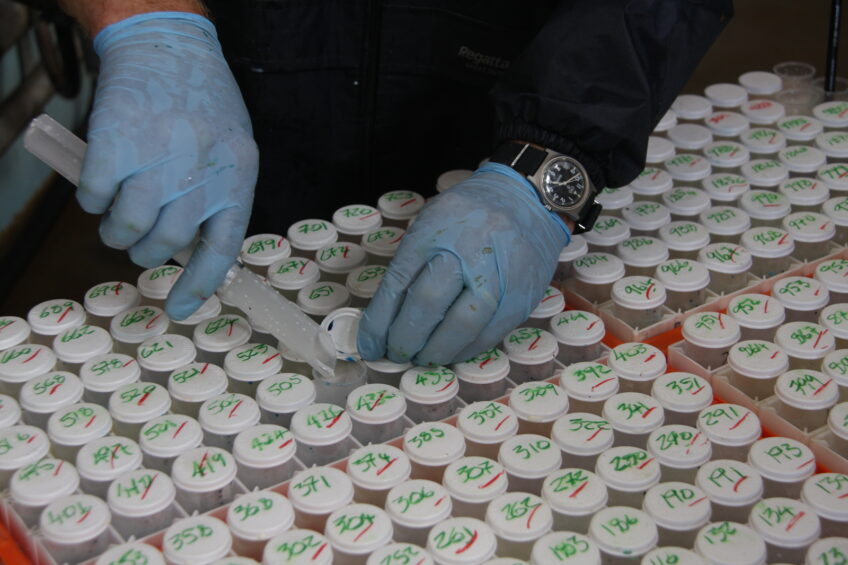Cell counts: A crucial tool in mastitis management

Cell counts is an essential tool for dairy farmers. A high cell count cow is a symptom of a subclinical mastitis problem. The key to then resolving a cell count problem is to ensure that low cell count cows are protected and remain free from infection.
Cell counts can affect the dairy farmer and the milk buyer in different ways. The amount of the desirable elements in milk decreases while the undesirable elements increase. Casein levels can be 20% lower in high cell count milk and so this has less value for cheese processors. The shelf life of high cell count milk is reduced due to increased levels of plasmin which breaks down milk protein and is not killed by pasteurisation. This is why milk buyers do not want and penalise high cell count milk.
A high herd cell count tells you that there are subclinical mastitis problems. There is no reason why any herd cannot have a cell count of 150,000 (commonly referred to as 150) all year round with an effective mastitis control programme. Milk appears perfectly normal with subclinical mastitis.
The only way that you can identify subclinical mastitis is by testing milk. Many people carry out regular individual cow cell counts and a cow free from subclinical mastitis will have a cell count under 200. You must carry out individual cow cell count tests to identify the problem cows to reduce a herd cell count.
Bacteria responsible for mastitis
Two bacteria are responsible for the majority of subclinical mastitis; Staph aureus and Strep uberis. Staph aureus is a contagious mastitis bacteria that only lives in the udder and on the teats. It is spread from cow to cow at milking time by the hands of the milker, the liners of the milking machine and common cloths if these are used.
Staph aureus forms micro-abscesses within the udder where the bacteria hide from white blood cells and antibiotics. Cure rates for Staph aureus infections are generally disappointing. Success with dry cow therapy in heifers can be up 90% if the infections are recent. Cure rates in old cows with chronic Staph aureus infections can be as low as 5%. Culling is the only option for chronically infected Staph aureus cows.
Strep uberis lives in the environment and in the udder and causes both clinical and subclinical mastitis. With clinical mastitis the milker will see changes in the milk such as clots or discolouration. Strep uberis is associated with the use of straw bedding, mastitis can occur when cows are at pasture and infections can enter the udder in the dry period. Cure rates for Strep uberis infections average between 60 and 70%.
Strep agalactiae can also cause high cell counts but this is less common. It lives in the udder and is only spread at milking time. This bacteria however, can be easy eliminated as antibiotic cure rates are very high.
TIPS TO REDUCE CELL COUNTS
Taking action with problem cows
Some dairy farmers only take action with the problem cows to manage cell count problems. A high cell count cow is a symptom of a subclinical mastitis problem. If you remove the symptom then these cows will be replaced by others who pick up infection. It’s essential that the spread of disease is controlled and then take action with the high cell count cows. This is a common mistake made by some.
It is important that low cell count cows are protected and remain free from infection. This is key to resolving a cell count problem. You must know which bacteria are causing the problem. Samples should be collected from about 10 high cell count cows and bulk milk. This should give an accurate indication of which bacteria are causing the problem.
A complete evaluation of mastitis management needs to be carried out to minimise spread of infection. Between four to five hours is normally spent on farm when carrying out mastitis visits. A lot of this time is spent in the parlour as this is where the majority of spread occurs.
Once the spread of infection has been minimised then action can be taken with problem cows. There are a range of options including:
Culling: Any decisions require careful consideration. You should only cull animals which you know will not respond to treatment. These are likely to be animals that have been persistently high for the last two lactations and have not responded to antibiotic dry cow therapy.
Drying off cows: Drying cows off early buys time and takes them out of the milking pool. This reduces the herd cell count and reduces the spread of infection.
Milking infected cows last: Milking high cell count cows last is an easy control measure that reduces the spread of infection.
Treatment during lactation: Treatment during lactation is generally disappointing with an average cure rate of around 40%. The only exception is Strep agalactiae treatments, although this is a less common cause of high cell count.
Discarding milk: Discarding milk to manipulate the herd cell count is extremely expensive and is crisis management.
No quick fix
It is important that sound decisions are based on good records, bacteriology and the herd circumstances. There is no quick fix to a high herd cell count problem. You will be looking at a period of a year to see a significant reduction. Short-term gains can be made by tackling those cows with the highest percent contribution to the bulk tank. The key is to have an effective plan that results in a steady reduction in cell count. Finally, it is also important that all progress is monitored and the plan amended as necessary.
Join 13,000+ subscribers
Subscribe to our newsletter to stay updated about all the need-to-know content in the dairy sector, two times a week.











